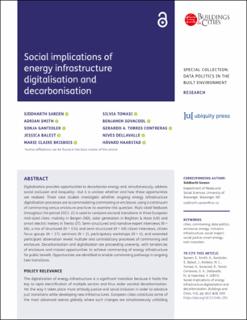| dc.contributor.author | Sareen, Siddharth | |
| dc.contributor.author | Smith, Adrian | |
| dc.contributor.author | Gantioler, Sonja | |
| dc.contributor.author | Balest, Jessica | |
| dc.contributor.author | Brisbois, Marie Claire | |
| dc.contributor.author | Tomasi, Silvia | |
| dc.contributor.author | Sovacool, Benjamin | |
| dc.contributor.author | Contreras, Gerardo A. Torres | |
| dc.contributor.author | Haarstad, Håvard | |
| dc.contributor.author | DellaValle, Nives | |
| dc.date.accessioned | 2024-02-02T15:18:51Z | |
| dc.date.available | 2024-02-02T15:18:51Z | |
| dc.date.created | 2024-01-28T01:06:53Z | |
| dc.date.issued | 2023 | |
| dc.identifier.citation | Sareen, S., Smith, A., Gantioler, S., Balest, J., Brisbois, M.C., Tomasi, S., Sovacool, B., Torres Contreras, G.A., DellaValle, N. & Haarstad, H. Social implications of energy infrastructure digitalisation and decarbonisation. Buildings & Cities, 4(1), 612–628 | en_US |
| dc.identifier.issn | 2632-6655 | |
| dc.identifier.uri | https://hdl.handle.net/11250/3115357 | |
| dc.description.abstract | Digitalisation provides opportunities to decarbonise energy and, simultaneously, address social exclusion and inequality—but it is unclear whether and how these opportunities are realised. Three case studies investigate whether ongoing energy infrastructure digitalisation processes are accommodating commoning or enclosure, using a continuum of commoning versus enclosure practices to examine this question. Multi-sited fieldwork throughout the period 2021–22 is used to compare sectoral transitions in three European mid-sized cities: mobility in Bergen (NO), solar generation in Brighton & Hove (UK) and smart electric meters in Trento (IT). Semi-structured and narrative expert interviews (N = 66), a mix of structured (N = 134) and semi-structured (N = 49) citizen interviews, citizen focus groups (N = 17), seminars (N = 2), participatory workshops (N = 4), and extended participant observation reveal multiple and contradictory processes of commoning and enclosure. Decarbonisation and digitalisation are proceeding unevenly, with tendencies of enclosure and missed opportunities to achieve commoning of energy infrastructure for public benefit. Opportunities are identified to enable commoning pathways in ongoing twin transitions. | en_US |
| dc.language.iso | eng | en_US |
| dc.publisher | Ubiquity Press | en_US |
| dc.rights | Navngivelse 4.0 Internasjonal | * |
| dc.rights.uri | http://creativecommons.org/licenses/by/4.0/deed.no | * |
| dc.subject | infrastruktur | en_US |
| dc.subject | urban infrastruktur | en_US |
| dc.subject | energi | en_US |
| dc.title | Social implications of energy infrastructure digitalisation and decarbonisation | en_US |
| dc.type | Peer reviewed | en_US |
| dc.type | Journal article | en_US |
| dc.description.version | publishedVersion | en_US |
| dc.subject.nsi | VDP::Samfunnsvitenskap: 200 | en_US |
| dc.source.pagenumber | 612–628 | en_US |
| dc.source.volume | 4 | en_US |
| dc.source.journal | Buildings & Cities | en_US |
| dc.source.issue | 1 | en_US |
| dc.identifier.doi | 10.5334/bc.292 | |
| dc.identifier.cristin | 2236049 | |
| cristin.ispublished | true | |
| cristin.fulltext | original | |
| cristin.qualitycode | 1 | |

